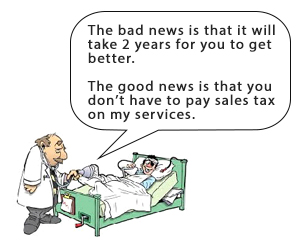Sales Tax Guide for Canadian Businesses
Allan Madan, CPA, CA
As a small business owner you may be responsible for filing a Canadian sales tax return in addition to your business income tax return. To help you better understand your GST/HST filing responsibilities, I have created this concise Sales Tax Guide for Canadian Businesses.

This guide is broken down into 5 parts:
1. Who needs to file the GST/HST Return
2. Taxable supplies, exempt supplies & zero-rated supplies – defined
3. GST/HST filing frequency
4. Instalment payments
5. Calculating your net GST/HST owing
1. Who needs to file the GST/HST return?
If you operate a business in Canada, you may have to collect and remit the Goods and Services Tax (GST) and the Harmonized Sales Tax (HST) and file the GST/HST return. As such, the first part of my Canadian Sales Tax Guide addresses the basic question, “Who Needs to file the GST/HST return?”
Businesses that have voluntarily registered to collect GST/HST on the sale of goods and services (known as ‘taxable supplies’) to customers in Canada must file a GST/HST return.
If you have not voluntarily registered, and if you are a ‘small supplier’, you do not have to collect GST/HST and will have no GST/HST filing responsibilities. You are a small supplier if you meet the following criteria:
- You are a sole-proprietor and your total revenues from taxable supplies from all of you businesses are $30,000 or less in the last four consecutive calendar quarters; or
- You are a partnership or corporation or public service body (i.e.: charity, not-for-profit organization, etc.) and your total revenues from taxable supplies (i.e. goods and services) are $30,000 or less in the last four consecutive calendar quarters.
If your business is not considered a small supplier (does not fall under the above criteria), you will be considered a mandatory GST/HST registrant and will have to collect and remit GST/HST and file the GST/HST return.
Please note that even if you are a small supplier, you can voluntarily register for GST/HST.
2. Taxable supplies, exempt supplies, and zero-rated supplies
The second part of my GST/HST Guide for Businesses in Canada explains the differences between taxable supplies, exempt supplies and zero rated supplies.
Most goods and services supplied in and imported into Canada are considered taxable supplies, with the exception of exempt and zero-rated supplies. GST/HST must be collected on sales made of taxable supplies to Canadians.
Exempt supplies
GST/HST does not apply to exempt supplies. Examples of exempt supplies include:

- sale of housing that was last used as a residence,
- residential accommodation rentals,
- health, medical, and dental services,
- child care services,
- educational services,
- music lessons, and
- financial services.
Zero-rate supplies
Zero-rated supplies are goods and services on which you do not charge GST/HST. Zero-rate supplies include:
- groceries (i.e.: milk and vegetables),
- agricultural products,
- livestock and fishery,
- prescription drugs,
- exported goods and services, and
- transportation services.
If your business provides goods and services that are not considered exempt or zero-rated supplies, you will have to charge and collect GST/HST on your sales.
See the chart below for a quick summary of the different classifications of goods & services for sales tax purposes:
| Classification | Tax Rate | Example |
| Exempt Supplies | None | Dental services |
| Zero Rate Supplies | 0% | Exported goods |
| Taxable Supplies | 13% (varies by province) | Computers |
3. GST/HST Filing Frequency
The third part of my Guide for Canadian Business on Sales Tax in Canada deals with the GST/HST return filing frequency. The filing frequency depends on your business’s total revenues from taxable supplies of goods and services made in Canada:
- If your taxable supplies are $1,500,000 or less, you will be required to file the GST/HST return annually;
- If your taxable supplies are more than $1,500,000 and less than $6,000,000, you will be required to file quarterly;
- If your taxable supplies are more than $6,000,000, you will have to file monthly.
If you are an annual filer, you will have to file the GST/HST return and remit any taxes owing within 3 months of the end of your fiscal year. If you are a monthly or quarterly filer, the GST/HST return and remittance of any taxes owing is due within 1 month after the end of the reporting period.
4. GST/HST instalment payments
If your net tax for a fiscal year is $3,000 or more, you may have to make quarterly instalment payments. The instalment amount is calculated as 1/4 of your net tax from the previous year but you can choose to estimate your tax liability. The instalment payments are due within 1 month after the end of each quarter. Failing to remit instalments may result in penalty and interest charges.
5. Calculating your net GST/HST
You can calculate your GST/HST using the regular method or the quick method.

Regular method
Under this approach, GST/HST tax is calculated as total GST/HST collected on taxable supplies minus Input Tax Credits (ITCs, which are GST/HST you paid on purchases related to commercial activities) minus any instalment payments you made during the fiscal year.
It is imperative that you keep good records to substantiate the GST/HST collected and ITCs claimed on your GST/HST return. In the event of an audit, you will need to support (with documentation) your assertions that all GST/HST sales have been reported and you incurred all ITCs you’ve claimed.
Quick Method
The quick method of accounting is an alternative method of calculating the GST/HST for small businesses. You will only be eligible for this method if your annual worldwide revenue from taxable supplies is $400,000 or less over the last four consecutive quarters. We strongly recommend the quick method of accounting for eligible small businesses due to reduced recordkeeping requirements.
To learn more about the benefits of quick method of accounting, please read my article – Quick method of Accounting
Disclaimer
The information provided on this page is intended to provide general information. The information does not take into account your personal situation and is not intended to be used without consultation from accounting and financial professionals. Allan Madan and Madan Chartered Accountant will not be held liable for any problems that arise from the usage of the information provided on this page.



